The best recommendations on how to prepare parsley for the winter and preserve the aroma
With the onset of cold weather, there are fewer fresh vegetables and fruits in the daily diet. And while experienced housewives stock up on canned food for future use, not everyone prepares spices. But don't underestimate their importance. After all, greens saturate dishes not only with a specific aroma, but also with additional vitamins. To preserve parsley and other herbs (for example, dill) for the winter, you need to know some nuances. We will tell you in detail how to properly prepare parsley for the winter at home in order to preserve the aroma in this article.
Features of storing parsley in winter
To parsley remained suitable for consumption for a long time in winter, it is necessary to carefully prepare it and choose a storage method. In unsuitable conditions, the product will lose nutritional value and spoil.
Save healthy fragrant spice possible by collecting its ground part in June. And the roots are harvested at the very end of summer.
Semi-finished parsley products are stored dried, frozen, salted and canned form.
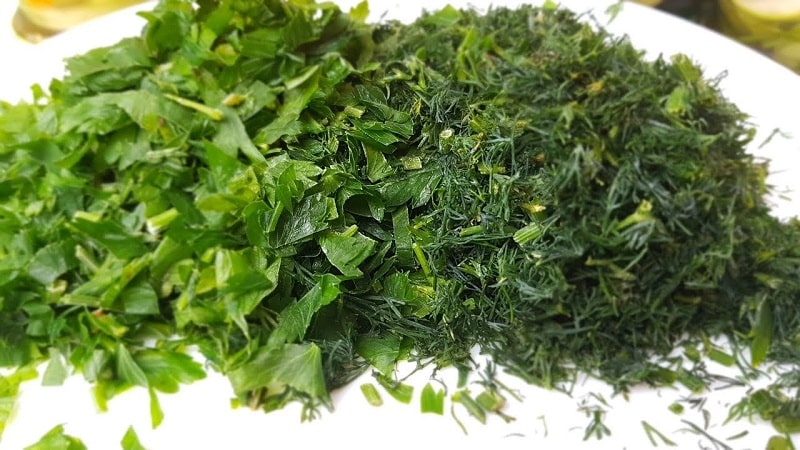
Preparation
Prepare parsley for winter storage as follows:
- separate the greens from the roots, as they need to be kept separately;
- remove dry and rotten parts of the plant;
- wash under cold running water;
- dried at room temperature.
After this, you can proceed to selecting a workpiece option.
Methods for preparing fresh parsley for the winter
There are many recipes that can satisfy the preferences of any housewife. Moreover, it is not difficult to create conditions for storing parsley.
Drying
This harvesting method results in a product that has a shelf life superior to all others. Once dried, parsley can be consumed throughout the year.
On open air
The method of drying spices in the open air is long but effective. Greens are dried whole sprigs or chopped.
How to dry:
- Rinse the greens and leave on a towel to drain excess liquid.
- Finely chop if desired.
- Spread in a thin layer (up to 1 cm) on sheets of paper without paint.
- Place in a well-ventilated area, for example, a glassed-in loggia.
- Choose a shaded corner to prevent yellowing of the product.
- Greens need to be turned over and shaken from time to time to avoid rotting and decay, to speed up the process.
- Based on the conditions, the plant can dry from 5 to 20 days.
- Upon completion of the drying process, the finished product is poured into prepared containers and stored at room temperature.
Parsley roots can also be dried outdoors. They are cut randomly and covered with insect gauze.
Important! You cannot dry the plant on newspapers because it absorbs printing ink. Iron baking sheets are also not suitable for drying, since the parsley on them can oxidize and turn black.
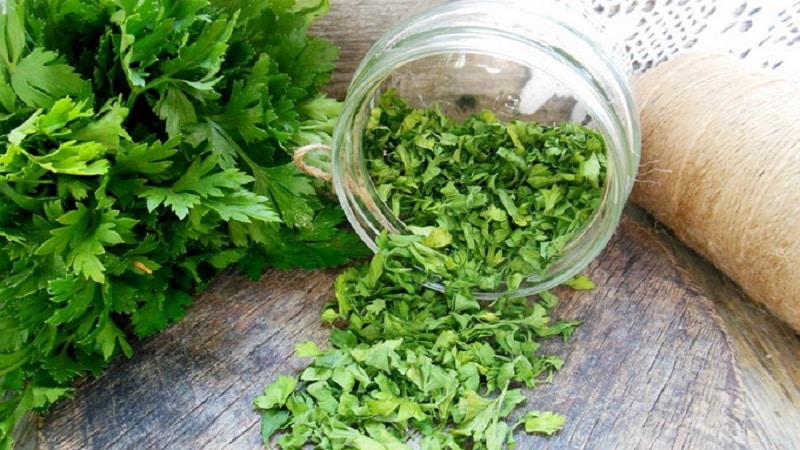
In the oven
This is one of the fastest ways to harvest greens and roots for the winter. It is important to monitor the temperature; the optimal range is from 40 to 60°C. Otherwise, the plant will burn and the beneficial substances will disappear.
Step-by-step instruction:
- The greens are laid out in sprigs or chopped and distributed in a thin layer on a baking sheet, the roots are cut into cubes or slices.
- Dry with the door open for 5 to 6 hours.
Freezing
With this method, not only the aroma is preserved, but also the maximum amount of vitamins that make up the plant. Both whole branches and the chopped mass are frozen.
For this storage method use:
- Plastic container;
- cling film;
- Vacuum package.
The greens are placed in sealed containers in portions for ease of later use. Vacuum bags must be tightly sealed to avoid product spoilage. And greens can be stored in cling film or foil, rolled up.
Reference. When stored in freezer It is recommended to label containers with herbs to avoid confusion with other spices.
A great option for freezing parsley is in ice cube trays. The resulting braces are very convenient for further use.
This is done as follows:
- greens are chopped with a knife or blender;
- Ice molds are filled two-thirds with the resulting mass;
- the remaining volume is filled with water and placed in the freezer until completely hardened;
- The resulting cubes are transferred to a bag and stored in the freezer.
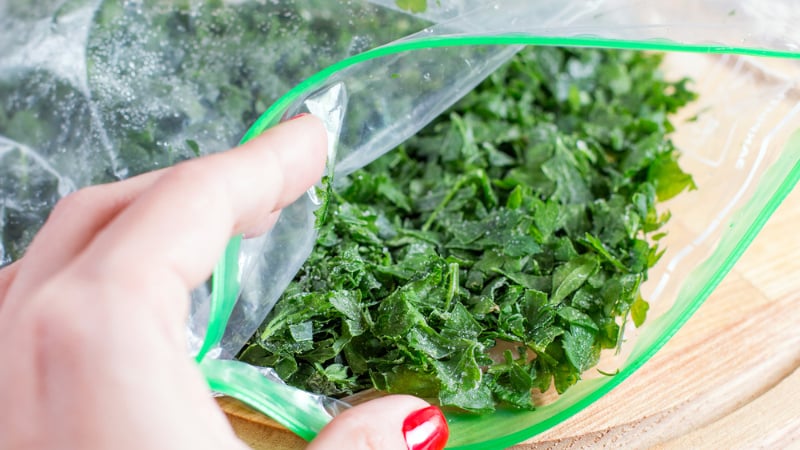
In the marinade
Pickled parsley has the shortest shelf life - no more than six months.
To prepare it you need:
- 2 kg parsley;
- 1 tbsp. l. salt;
- 2 tbsp. l. Sahara;
- 20 ml vinegar;
- 1 liter of water.
Cooking process:
- The greens are sorted and washed.
- Pack tightly into jars.
- Salt, sugar and vinegar are diluted in water and brought to a boil.
- The marinade is poured into jars with parsley and sterilized for 30 minutes in a pan with hot water up to the hangers (it is better to lay a napkin on the bottom).
It is recommended to store this parsley preparation in the basement or refrigerator.
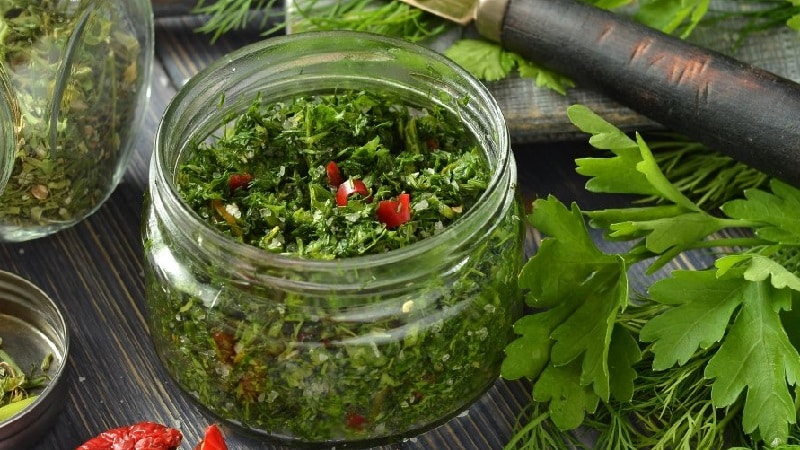
In vegetable oil
The washed and crushed spices are placed in sterilized jars and completely filled with oil. Shake the container several times to remove all air bubbles. In this form, the aromatic herb is stored in a cold place for 3 to 6 months.
Pickling
This type of preparation significantly extends the shelf life - up to 8-9 months.
Preparation:
- the greens are washed, dried, chopped;
- in a deep container, sprinkle with salt in a ratio of 1:5;
- knead, grind and place in prepared jars;
- compact the greens more tightly and cover with plastic lids.
You should not take large jars; the ideal volume is 0.5 liters.
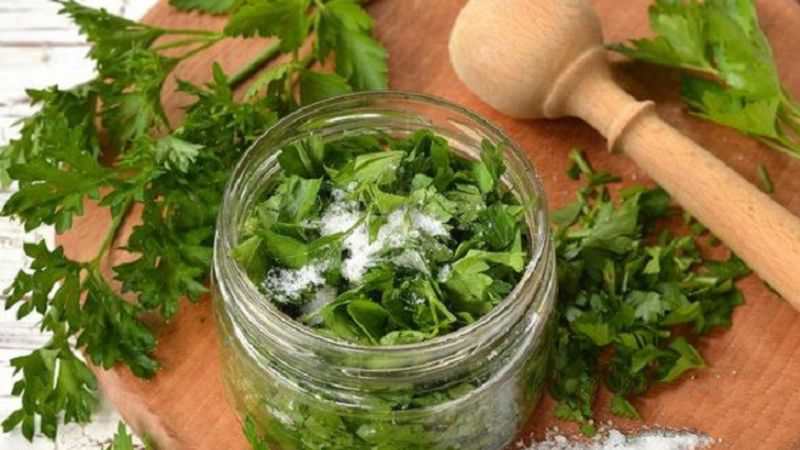
How long can it be kept without freezing?
When exposed to light, cut parsley begins to lose vitamin C within a few hours. Therefore, it is recommended to store it in a well-closed bag or container in the refrigerator.
But even in such conditions, it begins to lose its presentation literally after 1-2 days. Then the greens wither and deteriorate. In total, without freezing, the aromatic spice can be stored for a maximum of a month.
How to store at home
Storing winter parsley preparations directly depends on the method of their preparation.
At room temperature
It is usually recommended to keep products intended for storage at room temperature in kitchen cabinets. The container must be hermetically sealed to prevent the aroma from escaping.
Improper storage can lead to the development of mold and food pests. It is best to choose glass or plastic jars. The second must be marked “for food products”.Cloth and cardboard bags are also suitable for these purposes, but they are more difficult to maintain.
In a refrigerator
Pickled, salted, frozen and immersed in vegetable oil, parsley is excellently stored in the refrigerator. This can significantly extend the shelf life of the product.
But it is not recommended to use products from the same harvest for more than one year. For parsley in oil, the temperature regime must not exceed +7°C.
How to tell if parsley has gone bad
All preparations must be inspected periodically throughout the entire storage period. Dried parsley is considered spoiled if it begins to turn black or has mold in it. Removing only part of the product will not help, because harmful spores spread throughout the entire mass.
The pickled spice has gone bad if the color of the brine has changed. If it turns white, the product should be thrown away. The same thing happens with the workpiece in oil. Spoiled, salted and frozen parsley begins to turn black.
Conclusion
Preparing parsley for the winter does not require a lot of time and money. If the technology is followed, the plant does not lose its beneficial properties and taste for up to a year. And the suitability of a product can be determined simply by a change in its color.